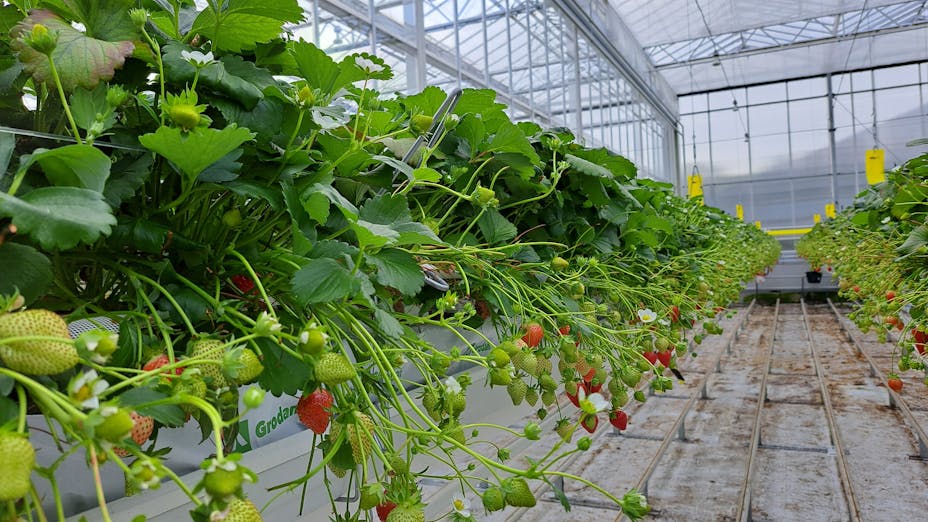

Firstly, although prices have dropped slightly since the extreme peaks of recent months, the high cost of energy continues to put pressure on strawberry growers because strawberries are an energy-intensive crop. Secondly, strawberries are a very labour-intensive crop in terms of propagating, planting, crop maintenance, harvesting and clearing out the greenhouse at the end of the cycle. Labour is scarce and therefore also costly, and although some activities can be automated or robotized and various advancements have been made, it is still early but there are already developments for strawberries and several of them have been tested in Delphy ISFC. The third pressing issue is water, because clean starting water is essential in strawberries, but good-quality water is becoming increasingly scarce. Besides that, it’s becoming more and more necessary for growers to recycle a large percentage – if not all – of their drain water due to legislative requirements, not to mention for cost reasons as fertilizer prices continue to rise. As a result, it is becoming increasingly interesting to cultivate strawberries in high-tech greenhouses, because it is much easier to precisely manage inputs such as energy and water in a controlled environment. Indoor cultivation has the added advantage of extending the crop cycle, so that growers can produce strawberries in the winter too to take advantage of market demand.
At Delphy, our business revolves around adding value by developing knowledge related to all crops and sharing it with growers worldwide. Therefore, we are continuously conducting research and looking for new and innovative ways to optimize crop cultivation, always with the grower in mind. For example, the ‘new way of growing’ and the Plant Empowerment philosophy is becoming more popular. It revolves around the idea that by keeping plants in balance you can maximize quality and yield while reducing the use of energy and water. Delphy has worked together with Grodan in previous studies. These have already enabled us to gain knowledge and experience about how stone wool helps growers to use water and nutrients more efficiently than other growing media with crops such as tomatoes, peppers and cucumbers. However, its use with strawberries is still a relatively new area for everyone. Therefore, when Grodan approached us with the idea of doing a trial, we saw it as a win-win situation: an opportunity for us to gain hands-on experience of what actually happens in the slab and therefore a better understanding of how strawberries take up water and nutrients from stone wool. Meanwhile, we could also help Grodan to validate their current knowledge and to further optimize their irrigation strategy guidelines and advice for strawberry propagators and growers in the future.

A recent trial by Grodan has demonstrated that strawberries can be propagated and cultivated on a stone wool substrate while maintaining high quality and attractive fruit size. Additionally, the yields and Brix values were higher than with traditional methods. “Our trial has shown that we have enough knowledge to grow good strawberry plants on stone wool. Everything is ready for upscaling,” says Johanna Bac-Molenaar from WUR.

In this Food Forward, we discuss the possibilities and challenges of growing strawberries in the greenhouse with three experts from the sector: Dieter Baets, Data Analyst and researcher Strawberries at Proefcentrum Hoogstraten, Ronald de Meester, Operational Director at Genson, and Hans Baekelmans, Crop Consultant at Grodan. They give updates on the latest trends and developments in greenhouse strawberry cultivation, and share their predictions for future-proof, efficient strawberry cultivation.
The trial, which will run for almost a year, started with propagating fresh unlighted everbearers in late autumn 2022 and then the plants were planted in the production compartment in mid-December. The aim is to investigate the plant development, growth, energy balance, production levels and quality at two different EC levels – the ‘normal’ level for strawberries and a higher level. We are using GroSens sensors directly in the slabs to continuously monitor the water content, EC and slab temperature. We’re also manually measuring the EC and pH of the gift water and slab water to analyse what’s going in, what’s coming out, and how the plant is reacting. The Grodan team have visited us several times and we have a weekly online meeting with them to discuss the latest results, using Grodan’s six-phase model for the cultivation process as a basis. It’s good that the Grodan team are so involved because this maximizes how much we can learn from one another and also means that we can make quick decisions about whether we need to fine-tune the strategy for the coming week based on changes in the climate, external light level and so on.

Global strawberry cultivation is at a turning point. Growers are faced with sharp cost increases, while they also need to continue to guarantee high quality and consistent products, as consumers demand healthy, fresh fruits throughout the year. That is why strawberry propagators and growers are constantly looking for ways to optimise their growth strategy, maximise their yields and minimise their costs. This is the reason for the increasing trend towards the production of everbearers worldwide.
While working with the stone wool, I noticed that strawberry propagation is very different – not only because it’s done inside rather than outside, but also because this cultivation concept using fresh everbearers means that it can be done later than normal and for a shorter period than when doing a traditional propagation. The day of planting was less labour-intensive than normal, because we just had to put the blocks onto the slabs rather than having to actually plant the tray plant into the growing media. In terms of watering strategy, it has been interesting for me to learn that there’s another way of giving water, and it has been fascinating to see the influence of changing the water strategy in combination with light and temperature.
The start of the strawberry cultivation was a bit slower this year due to the many dark days we’ve had. Due to following a certain radiation-temperature ratio (RTR) strategy from Plant Empowerment, less energy was used and this contributed to the slower start. Since then, however, the plants have developed well on the stone wool at both EC levels. They are full of flowers and producing high-quality fruits with a good average fruit weight, good Brix levels and a high yield, plus new trusses keep on forming which is a sign of a well-balanced plant. Strawberry plants begin forming some trusses in the propagation period, so it’s especially important to give them a good start, and I believe that this is also possible on stone wool. In addition, in combination with clean water, stone wool reduces the chance of soilborne diseases and we’ve had no problems with Phytophthora in this trial. Besides that, another finding is that using stone wool in a controlled environment can enable you to steer very precisely on the right nutrients, which results in a better developed rhizome and therefore a stronger plant and ultimately higher production later on.
I believe the traditional strawberry cultivation techniques will still be around for some time, but the year-round cultivation of everbearers in high-tech greenhouses will become more popular as the challenges I mentioned earlier increasingly affect the choices of growers. For example, as the restrictions on crop protection agents continue to tighten, they will need to find new ways to cultivate a balanced and healthy plant while also reducing their costs and consumption of resources. High-tech greenhouses enable growers to carefully manage water and fertilization in this context, plus the higher temperatures and opportunities for year-round production make it more economically viable to use biologicals and beneficial insects as part of an Integrated Pest Management approach. In combination with sensors to monitor and evaluate the water content and EC, stone wool can play a significant role in this shift to high-tech growing.
Strawberry cultivation on stone wool is currently still in the innovation phase and it’s a steep learning curve for all of us, so a follow-up trial has already been planned with Grodan to support more research and validation. Real-life results with a number of early adopters in Canada are already demonstrating that stone wool holds a real potential for strawberries, providing that growers truly want to move forward and are prepared to learn about a new irrigation strategy. Grodan’s experience and commitment makes the company well placed to have significant influence in this sector in the future – not only in Canada, but also internationally. Right now, I would say that stone wool is most suitable for bigger strawberry growers who are able to make the necessary investments to change their propagation approach, or for growers who don’t do their own propagating. But with the right knowledge and guidelines, eventually it could be possible for all strawberry growers to use stone wool.
We are a global leader in the supply of innovative stone wool substrate solutions for the professional horticultural based on Precision Growing principles.